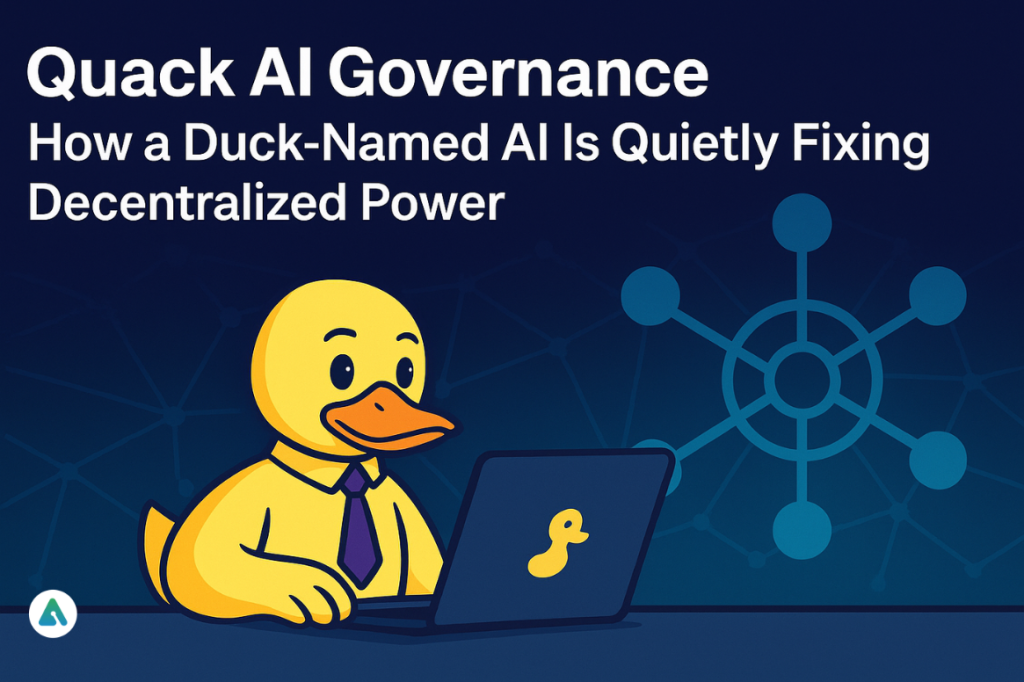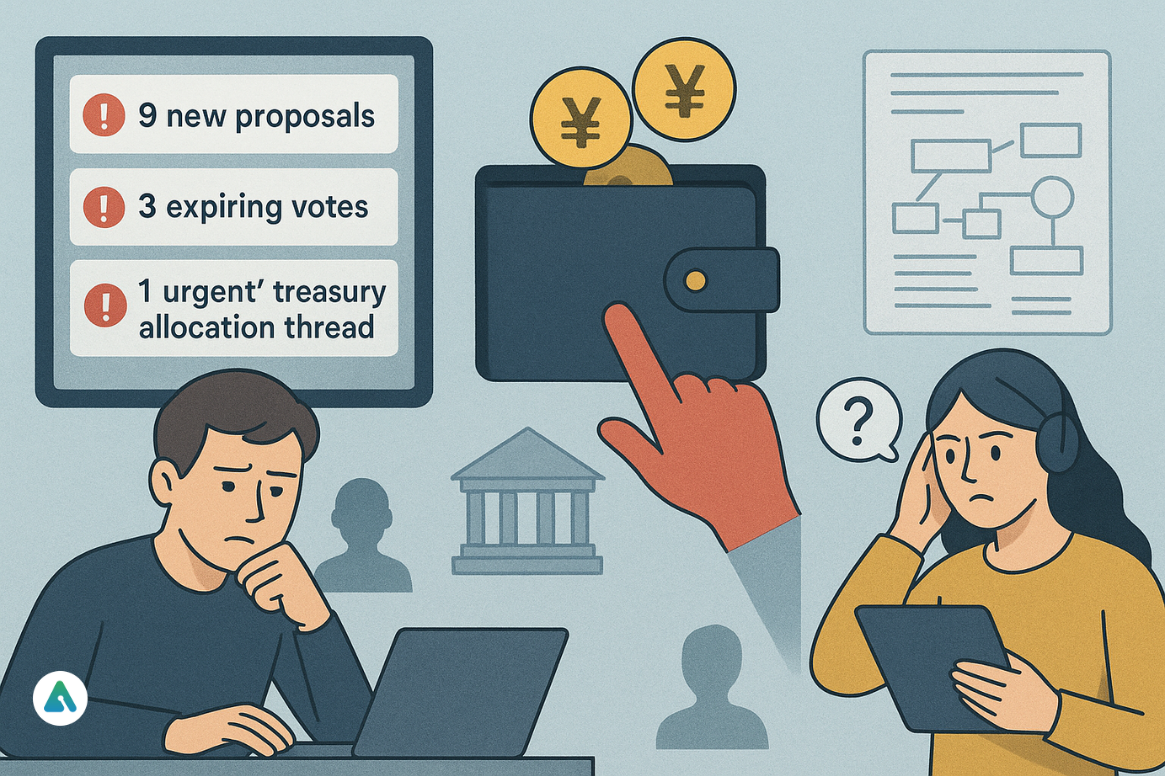Let’s be real for a second — decentralized governance was supposed to free us.
No CEOs. No boardrooms. Just pure democracy on-chain.
But somewhere between utopia and execution, we hit a wall. A big, expensive, “who-the-heck-voted-for-that” kind of wall.
It’s 3 a.m. in Singapore. Noon in New York. A major DAO just launched a vote on moving $50 million into a new DeFi partnership. By the time half the world wakes up, three whale wallets have already decided the outcome.
Ten thousand smaller holders? They never even saw the proposal.
Welcome to DAO governance in 2025 — transparent on paper, broken in practice.
According to DeepDAO’s 2025 Governance Report, average voter participation hovers between 3 and 8 percent. Even worse, over 70 percent of governance power in major DeFi projects sits in fewer than 20 wallets. That’s not decentralization. That’s digital feudalism with a Discord server.
And into this mess waddles something that sounds like a meme: Quack AI Governance.
Ridiculous name. Serious tech. And somehow, this duck might just save DAO governance from itself.
Why the System Cracked in the First Place
Before we talk solutions, let’s face the ugly truths about DAO life.
1. Governance Fatigue Is Real
If you’re in multiple DAOs, your notifications look like this:
9 new proposals.
3 expiring votes.
1 “urgent” treasury allocation thread that’s 43 pages long.
Even the most dedicated members can’t read every cross-chain integration plan or treasury-management PDF. People have jobs, kids, lives. Governance has become a full-time gig nobody signed up for.
2. The Whale-Wallet Problem
When 5% of wallets cast 80% of votes, decentralization becomes a myth.
One mid-tier protocol even discovered that 73% of its decisions were controlled by just 11 wallets. That’s like saying your entire city council consists of one apartment building.
3. Complexity That Locks People Out
DAO proposals read like cryptography mixed with legalese.
Terms like “optimistic rollup validation” and “slashing conditions for validator misconduct” might excite blockchain devs, but for regular members, it’s white noise.
When people don’t understand, they either skip voting or follow whoever yells the loudest on X (formerly Twitter).
That’s not governance — that’s groupthink at gas-fee scale.
Enter Quack AI: The Governance Co-Pilot We Didn’t Know We Needed
At first glance, “Quack AI Governance” sounds like a meme-coin side quest.
But beneath the branding is a serious AI-powered governance layer built to do one thing: make decentralized decision-making actually intelligent.
Think of Quack AI as a co-pilot, not an autopilot.
>It doesn’t vote for you. It doesn’t seize control. It just reads everything — every line of a proposal, every bit of smart-contract logic — and summarizes the real risks before you hit “Vote.”
It’s the DAO equivalent of having a brilliant, sleep-deprived friend who’s already done all the homework and says, “Hey, don’t sign that — there’s a loophole on page 27.”
Humans + AI = Governance That Works
Quack AI’s philosophy is refreshingly sane: AI analyzes, humans decide.
The system uses AI agents to score proposals, identify red flags, and predict outcomes, but it leaves the final judgment to human wallets.
That balance matters. The crypto community has always feared “algorithmic tyranny,” where bots make executive calls. Quack AI avoids that trap.
It’s not replacing human values — it’s amplifying human clarity.
How Quack AI Governance Actually Works (The No-Jargon Breakdown)
Here’s what happens when a DAO integrates Quack AI:
1. Proposal Scoring System
The moment a new proposal goes live, Quack’s AI agents spring into action. They evaluate it across multiple vectors:
-
Treasury Impact: What’s the real cost? Any hidden liabilities?
-
Security Risk: Does the code open new attack vectors?
-
Historical Precedent: Have similar ideas failed elsewhere?
-
Community Benefit: Who truly gains here — the DAO or a few insiders?
-
Cross-Chain Effects: Will it mess with partner protocols or liquidity pools?
The AI then issues a Proposal Quality Score (PQS) — not just a “yes/no,” but a color-coded snapshot of strengths, risks, and unknowns.
2. Integration Without Migration
Unlike past governance “solutions” that forced DAOs to rebuild everything, Quack AI works on top of existing systems. It connects via API to platforms like Snapshot, Tally, or MANTRA Chain, analyzing data without demanding migration.
That plug-and-play model is a game-changer. Lower friction = faster adoption.
3. Smart-Contract Simulations
Before any governance proposal triggers a contract change, Quack AI runs pre-execution simulations — a kind of flight simulator for DeFi votes.
If the simulation predicts a treasury drain, liquidity lock, or exploit risk, the system flags it.
In early pilots, Quack AI caught a proposal that would have accidentally given a single wallet unlimited minting authority.
One missed line of code, $10 million saved. Not bad for a duck.
The AIQ Token: Utility with a Pulse
Yes, Quack AI has a token — AIQ — but it’s not your typical governance gimmick. Its utility rests on three legs:
-
Access: Staking AIQ unlocks deeper risk reports and cross-protocol analysis.
-
Meta-Governance: Holders vote on updates to Quack AI itself — new integrations, algorithm tweaks, feature priorities.
-
Incentive Alignment: DAOs that stake AIQ get priority AI resources and faster model updates.
It’s not perfect (tokenomics rarely are), but compared with the “vote coupon” tokens of 2022, this one actually does something.
Real-World Wins: From Treasury Saves to Cross-Chain Insights
The $10 Million Save
In early 2025, a mid-sized DeFi DAO proposed allocating $10 million into a new liquidity-mining partnership.
Quack AI’s analysis found a buried clause: an admin key that could extend the lock-up period from 3 to 6 months.
The DAO amended the proposal, removed the key, and proceeded safely.
Result → Treasury grew, no drama, no “oops” moment.
Cross-Protocol Risk Detection
When a lending protocol changed its collateral rules, Quack AI noticed the move would ripple into three dependent protocols that used its price oracle.
The AI flagged the issue, the teams coordinated, and a potential $30 million exposure vanished overnight.
Real-World Asset Tokenization
In a DAO exploring commercial real estate tokenization, Quack AI flagged legal gray zones in two jurisdictions and missing tax-obligation clauses in the smart contract.
That analysis saved the project from months of legal cleanup and prevented a potential compliance nightmare.
The MANTRA Chain Partnership
MANTRA Chain, known for its regulated blockchain infrastructure, integrated Quack AI to analyze proposals for compliance and risk.
This allowed MANTRA to process decisions 40% faster, according to its Q2 2025 report, without sacrificing oversight.
The pattern is clear: Quack AI doesn’t take away human agency — it makes human decisions smarter, faster, and safer.
Under the Hood: What Makes This Duck So Smart?
Let’s lift the lid without drowning in code.
NLP for Proposal Parsing
Governance proposals are a linguistic mess — half legal contract, half Reddit thread.
Quack AI uses advanced Natural Language Processing models (think fine-tuned LLaMA and Mistral variants) to break them down into plain language, tag potential red flags, and summarize implications.
Historical Learning Engine
Trained on 10,000 + past DAO proposals, both successful and catastrophic, the system recognizes the early signals of bad governance: vague language, unverified claims, or treasury exposure patterns.
It’s like an AI that’s read every post-mortem in DeFi history and refuses to let you repeat it.
Cross-Chain Monitoring Layer
DAOs don’t live on one chain anymore. Ethereum, Linea, MANTRA, Arbitrum — governance moves fast everywhere.
Quack AI maintains a live, multi-chain data map tracking protocol dependencies, smart-contract interactions, and treasury flows.
If one change on Ethereum threatens liquidity on Linea, it knows — and tells you before the fire starts.
The PQS Algorithm in Action
While details are proprietary, the Proposal Quality Score weighs three categories:
-
Risk Profile (40%) — Security, treasury exposure, exploit probability.
-
Logic Consistency (35%) — Internal contradictions, missing dependencies, unverified assumptions.
-
Tokenomics Impact (25%) — Effects on supply, governance weight, and long-term community health.
Scores update dynamically as community discussions evolve, creating a living, breathing risk index for every DAO proposal.
Critics & Concerns: Does AI Make Governance Too Centralized?
Fair question.
Some worry that if too many DAOs rely on a single AI system, decision-making could become subtly centralized.
Quack AI’s team seems aware of that — their roadmap includes open-source transparency for AI models, on-chain verification of analysis logs, and decentralized model training via federated learning.
Still, the tension remains. Automation versus independence.
But as 2025 has shown, ignorance isn’t decentralization. Informed choices are.
The Human Side of All This
Underneath the layers of code, Quack AI is trying to solve something profoundly human: trust fatigue.
People joined DAOs to feel ownership, not exhaustion.
They wanted to vote, not scroll through jargon until their eyes glaze over.
By turning data chaos into clarity, Quack AI reminds us that decentralization only works when humans can actually participate.
The duck joke might grab attention, but what it’s really teaching DAOs is this:
“Decentralization without intelligence is just noise.”
Looking Ahead to 2026: The Future of AI-Governed Governance
Here’s what’s on the horizon — and it’s surprisingly pragmatic:
-
Predictive Voting Models: AI suggesting turnout incentives based on historical voter behavior.
-
Regulatory Bridges: Automated checks for global compliance in RWA tokenization.
-
Ethical Scoring: Weighting proposals against community values, not just technical soundness.
-
AI DAO Networks: Inter-DAO communication via AI agents for cross-protocol coordination.
In other words, governance is evolving from static votes to adaptive decision ecosystems.
If 2020–2024 was about decentralization, 2025–2030 is about intelligent decentralization — powered by AI, refined by humans.
Final Thoughts: The Duck That Taught DAOs to Fly
Quack AI’s biggest achievement isn’t automation — it’s empowerment.
It took a system drowning in noise and gave it back its voice.
For the first time in years, DAO members can read, understand, and vote with confidence.
Sure, it’s ironic that the project making governance intelligent is named after a duck. But maybe that’s the point.
Because every revolution starts with something people laughed at — until it started working.
So next time you see a DAO vote pop up at 3 a.m., know this: somewhere, an AI duck is reading it for you, checking the fine print, and whispering,
“Hey friend, maybe don’t fly off that cliff.”
Visit: AIInsightsNews




